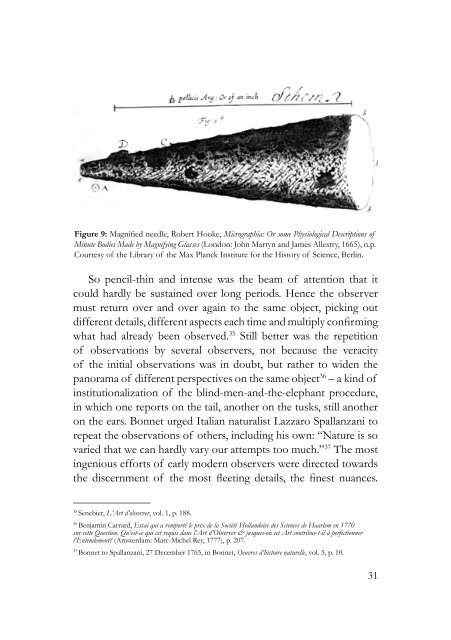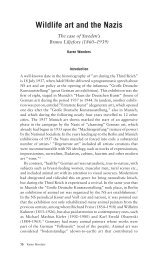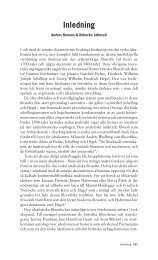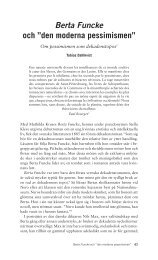Observation as a Way of Life: Time, Attention, Allegory
Observation as a Way of Life: Time, Attention, Allegory
Observation as a Way of Life: Time, Attention, Allegory
You also want an ePaper? Increase the reach of your titles
YUMPU automatically turns print PDFs into web optimized ePapers that Google loves.
Figure 9: Magnified needle, Robert Hooke, Micrographia: Or some Physiological Descriptions <strong>of</strong><br />
Minute Bodies Made by Magnifying Gl<strong>as</strong>ses (London: John Martyn and James Allestry, 665), n.p.<br />
Courtesy <strong>of</strong> the Library <strong>of</strong> the Max Planck Institute for the History <strong>of</strong> Science, Berlin.<br />
So pencil-thin and intense w<strong>as</strong> the beam <strong>of</strong> attention that it<br />
could hardly be sustained over long periods. Hence the observer<br />
must return over and over again to the same object, picking out<br />
different details, different <strong>as</strong>pects each time and multiply confirming<br />
what had already been observed. 5 Still better w<strong>as</strong> the repetition<br />
<strong>of</strong> observations by several observers, not because the veracity<br />
<strong>of</strong> the initial observations w<strong>as</strong> in doubt, but rather to widen the<br />
panorama <strong>of</strong> different perspectives on the same object 6 – a kind <strong>of</strong><br />
institutionalization <strong>of</strong> the blind-men-and-the-elephant procedure,<br />
in which one reports on the tail, another on the tusks, still another<br />
on the ears. Bonnet urged Italian naturalist Lazzaro Spallanzani to<br />
repeat the observations <strong>of</strong> others, including his own: “Nature is so<br />
varied that we can hardly vary our attempts too much.” 7 The most<br />
ingenious efforts <strong>of</strong> early modern observers were directed towards<br />
the discernment <strong>of</strong> the most fleeting details, the finest nuances.<br />
5 Senebier, L’Art d’observer, vol. , p. 88.<br />
6 Benjamin Carrard, Essai qui a remporté le prix de la Société Hollandoise des Sciences de Haarlem en 1770<br />
sur cette Question. Qu’est-ce qui est requis dans l’Art d’Observer & jusques-où cet Art contribue-t-il à perfectionner<br />
l’Entendement? (Amsterdam: Marc-Michel Rey, 777), p. 207.<br />
7 Bonnet to Spallanzani, 27 December 765, in Bonnet, Oeuvres d’histoire naturelle, vol. 5, p. 0.






